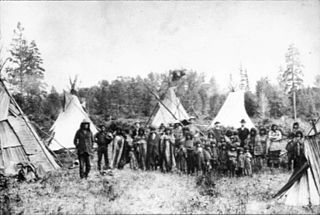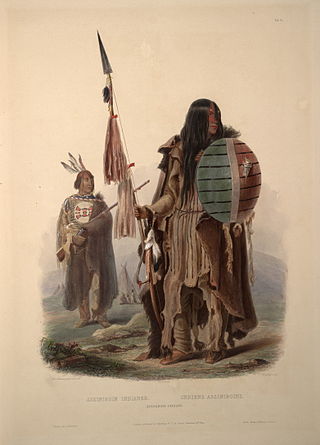The Blackfoot or Blackfeet are groups of people from the Blackfoot language-speaking nations who constitute the Blackfoot Confederacy that spans Canada and the United States.
Contents
Blackfoot or Blackfeet may also refer to:
The Blackfoot or Blackfeet are groups of people from the Blackfoot language-speaking nations who constitute the Blackfoot Confederacy that spans Canada and the United States.
Blackfoot or Blackfeet may also refer to:

The Nez Perce are an Indigenous people of the Plateau who still live on a fraction of the lands on the southeastern Columbia River Plateau in the Pacific Northwest. This region has been occupied for at least 11,500 years.

The Piegan are an Algonquian-speaking people from the North American Great Plains. They are the largest of three Blackfoot-speaking groups that make up the Blackfoot Confederacy; the Siksika and Kainai are the others. The Piegan dominated much of the northern Great Plains during the nineteenth century.
A gem, or gemstone, is a cut rock or mineral.
Paris is the capital of France, which may consist of :

The Blackfoot Confederacy, Niitsitapi, or Siksikaitsitapi, is a historic collective name for linguistically related groups that make up the Blackfoot or Blackfeet people: the Siksika ("Blackfoot"), the Kainai or Blood, and two sections of the Peigan or Piikani – the Northern Piikani (Aapátohsipikáni) and the Southern Piikani. Broader definitions include groups such as the Tsúùtínà (Sarcee) and A'aninin who spoke quite different languages but allied with or joined the Blackfoot Confederacy.

The Blackfoot language, also called Siksiká, often anglicised as Siksika, is an Algonquian language spoken by the Blackfoot or Niitsitapi people, who currently live in the northwestern plains of North America. There are four dialects, three of which are spoken in Alberta, Canada, and one of which is spoken in the United States: Siksiká (Blackfoot), to the southeast of Calgary, Alberta; Kainai, spoken in Alberta between Cardston and Lethbridge; Aapátohsipikani, to the west of Fort MacLeod which is Brocket (Piikani) and Aamsskáápipikani, in northwestern Montana. The name Blackfoot probably comes from the blackened soles of the leather shoes that the people wore.
Cascade, Cascades or Cascading may refer to:

The Kutenai, also known as the Ktunaxa, Ksanka, Kootenay and Kootenai, are an indigenous people of Canada and the United States. Kutenai bands live in southeastern British Columbia, northern Idaho, and western Montana. The Kutenai language is a language isolate, thus unrelated to the languages of neighboring peoples or any other known language.
Kootenay, Kootenai, and Kutenai may refer to:

The Pi'ikanni Nation is a First Nation, representing the Indigenous people in Canada known as the Northern Piikani or simply the Peigan.

The Assiniboine or Assiniboin people, also known as the Hohe and known by the endonym Nakota, are a First Nations/Native American people originally from the Northern Great Plains of North America.

The Blackfeet Nation, officially named the Blackfeet Tribe of the Blackfeet Indian Reservation of Montana, is a federally recognized tribe of Siksikaitsitapi people with an Indian reservation in Montana. Tribal members primarily belong to the Piegan Blackfeet band of the larger Blackfoot Confederacy that spans Canada and the United States.
First Nations in Alberta are a group of people who live in the Canadian province of Alberta. The First Nations are peoples recognized as Indigenous peoples or Plains Indians in Canada excluding the Inuit and the Métis. According to the 2011 Census, a population of 116,670 Albertans self-identified as First Nations. Specifically there were 96,730 First Nations people with registered Indian Status and 19,945 First Nations people without registered Indian Status. Alberta has the third largest First Nations population among the provinces and territories. From this total population, 47.3% of the population lives on an Indian reserve and the other 52.7% live in urban centres. According to the 2011 Census, the First Nations population in Edmonton totalled at 31,780, which is the second highest for any city in Canada. The First Nations population in Calgary, in reference to the 2011 Census, totalled at 17,040. There are 48 First Nations or "bands" in Alberta, belonging to nine different ethnic groups or "tribes" based on their ancestral languages.

The Gros Ventre, also known as the Aaniiih, A'aninin, Haaninin, Atsina, and White Clay, are a historically Algonquian-speaking Native American tribe located in northcentral Montana. Today, the Gros Ventre people are enrolled in the Fort Belknap Indian Community of the Fort Belknap Reservation of Montana, a federally recognized tribe with 7,000 members, also including the Assiniboine people.

Chief Mountain is located in the U.S. state of Montana on the eastern border of Glacier National Park and the Blackfeet Indian Reservation. The mountain is one of the most prominent peaks and rock formations along the Rocky Mountain Front, a 200 miles (320 km) long overthrust fault, known as the Lewis Overthrust, which extends from central Montana into southern Alberta, Canada.
There are a vast array of myths surrounding the Blackfoot Native Americans as well as Aboriginal people. The Blackfeet inhabit the Great Plains, in the areas known as Alberta, Saskatchewan, and areas of Montana. These stories, myths, origins, and legends play a big role in their everyday life, such as their religion, their history, and their beliefs. Only the elders of the Blackfoot tribes are allowed to tell the tales, and are typically difficult to obtain because the elders of the tribes are often reluctant to tell them to strangers who are not of the tribe. People such as George B. Grinnell, John Maclean, D.C. Duvall, Clark Wissler, and James Willard Schultz were able to obtain and record a number of the stories that are told by the tribes.
The following is an alphabetical list of topics related to Indigenous peoples in Canada, comprising the First Nations, Inuit and Métis peoples.
The Iron Confederacy or Iron Confederation was a political and military alliance of Plains Indians of what is now Western Canada and the northern United States. This confederacy included various individual bands that formed political, hunting and military alliances in defense against common enemies. The ethnic groups that made up the Confederacy were the branches of the Cree that moved onto the Great Plains around 1740, the Saulteaux, the Nakoda or Stoney people also called Pwat or Assiniboine, and the Métis and Haudenosaunee. The Confederacy rose to predominance on the northern Plains during the height of the North American fur trade when they operated as middlemen controlling the flow of European goods, particularly guns and ammunition, to other Indigenous nations, and the flow of furs to the Hudson's Bay Company (HBC) and North West Company (NWC) trading posts. Its peoples later also played a major part in the bison (buffalo) hunt, and the pemmican trade. The decline of the fur trade and the collapse of the bison herds sapped the power of the Confederacy after the 1860s, and it could no longer act as a barrier to U.S. and Canadian expansion.

Mountain Chief was a South Piegan warrior of the Blackfoot Tribe. Mountain Chief was also called Big Brave (Omach-katsi) and adopted the name Frank Mountain Chief. Mountain Chief was involved in the 1870 Marias Massacre, signed the Treaty of Fort Laramie in 1868, and worked with anthropologist Frances Densmore to interpret folksong recordings.
Hugh Monroe (1798-1892) was a Canadian trapper, guide, and interpreter. He worked for Hudson's Bay Company, American Fur Company, and independently throughout his life. He traveled with Chief Lone Walker of the Piikani Nation and was given the name "Rising Wolf", an ancestor of Lone Walker, with Rising Wolf Mountain later named after him.